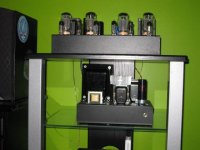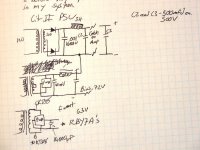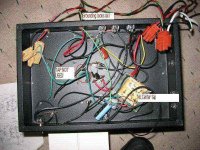Since the recent completion of my amplifier, all but one problem remains, The dreaded power transformer hum. Its not the mechanical humming of the transformer that annoys me, but the fact its making its way into my speakers. (can be heard from +5 feet away)
The transformer is a Hammond 717 rated 510-0-510VAC at 500ma
Power Supply configuration
PXformer > Full Wave rectifier > Small HV Cap > 3H choke > 2 big caps
- I'm pretty sure its not the bias or the filament, but I can not be sure because my oscilloscope decided to eat itself.
- And the hum is absent if I power the amp from my bench supply.
- I have tried using it on different house circuits.
I am aware that Hammond transformers are bad and I will not use them for future projects.
Is there anyway to filter this out?
Could it be DC offset?
Thank You.
Keith
The transformer is a Hammond 717 rated 510-0-510VAC at 500ma
Power Supply configuration
PXformer > Full Wave rectifier > Small HV Cap > 3H choke > 2 big caps
- I'm pretty sure its not the bias or the filament, but I can not be sure because my oscilloscope decided to eat itself.
- And the hum is absent if I power the amp from my bench supply.
- I have tried using it on different house circuits.
I am aware that Hammond transformers are bad and I will not use them for future projects.
Is there anyway to filter this out?
Could it be DC offset?
Thank You.
Keith
Schematic, picture of the amp? Both would be useful for anyone trying to help. Are your OPT's close to the power transformer? Could be inductive coupling if it's at the mains frequency. Try putting a sheet of metal between the power trans. and the OPT. Anything will do for a test, but the thicker the better.
Sheldon
Sheldon
Some more info about the signal topology please (se or pp, which tubes etc.)! Your choice of power trafo suggests something rather exotic (or massive overkill  )
)
If it isn't power supply humm (100/120hz; simulate using duncan's psud to get an idea about ripple magnitude) it's probably an unshielded small signal wire or B+ wire running parallel with AC filament wires (be sure to twist them well). I can't see how the power trannie could be causing this though.
edit: Sheldon beat me to it, I agree with his assessment of magnetic coupling.
Simon
 )
)If it isn't power supply humm (100/120hz; simulate using duncan's psud to get an idea about ripple magnitude) it's probably an unshielded small signal wire or B+ wire running parallel with AC filament wires (be sure to twist them well). I can't see how the power trannie could be causing this though.
edit: Sheldon beat me to it, I agree with his assessment of magnetic coupling.
Simon
Keith,
I am not familiar with Hammond transformers, but one of your remarks is indicative. You say the hum is absent when using your bench supply. What is different with that from the rest of the house's plugs?
My first thought has to do with earthing. Can you say whether it is 60 Hz or 120 Hz (for the USA), or is it a hum "of indeterminable pitch" as the classic description goes, i.e. a rather buzzing noise without any particular frequency content? Do you get this hum with the volume control set how? With ancillaries connected or not? A pity that your scope has taken a holiday.
For now I think these factors could be indicative. Other members will hopefully join soon.
Regards.
I am not familiar with Hammond transformers, but one of your remarks is indicative. You say the hum is absent when using your bench supply. What is different with that from the rest of the house's plugs?
My first thought has to do with earthing. Can you say whether it is 60 Hz or 120 Hz (for the USA), or is it a hum "of indeterminable pitch" as the classic description goes, i.e. a rather buzzing noise without any particular frequency content? Do you get this hum with the volume control set how? With ancillaries connected or not? A pity that your scope has taken a holiday.
For now I think these factors could be indicative. Other members will hopefully join soon.
Regards.
Okay More information. (Picture Included)
The Amplifier is based off of a HK Citation II. This is a PP type and can do about 60wpc. Uses 4x KT-88(EH) and 6x 12BY7A's
-I can hear some120 cycle but a majority is 60 cycles from the speakers
Schematic
I have some modifications on the amp
- The original Power supply design calls for a voltage doubler, no way that was going in...
-Feed Back Loops had to be adjusted so the Hammond 1650N OPTs could be used
- Amp is triode strapped
- 12BY7A's filament is filtered DC, KT88 is still AC
- Ignore the Pentium 4 Heatsink sitting on the filament xformer,( its slightly overloaded.)
Keith
The Amplifier is based off of a HK Citation II. This is a PP type and can do about 60wpc. Uses 4x KT-88(EH) and 6x 12BY7A's
-I can hear some120 cycle but a majority is 60 cycles from the speakers
Schematic
I have some modifications on the amp
- The original Power supply design calls for a voltage doubler, no way that was going in...
-Feed Back Loops had to be adjusted so the Hammond 1650N OPTs could be used
- Amp is triode strapped
- 12BY7A's filament is filtered DC, KT88 is still AC
- Ignore the Pentium 4 Heatsink sitting on the filament xformer,( its slightly overloaded.)
Keith
Attachments
Try moving the power supply further away from the amplifier, that should confirm or eliminate the magnetic coupling theory. Given the already significant distance involved I think it unlikely. Note that the radiated field of most power transformers contains harmonics (some second and usually a lot more 3rd) of the line frequency, and as the core approaches saturation you will see a lot of 3rd harmonic in the flux.
More likely you have a wiring issue in the power supply that is modulating the ground returns with rectifier ripple. This is the likely cause if the noise is 120Hz buzz. 60 Hz hum is relatively flat sounding, 120Hz buzz has a sharp edge to it.
Your transformer center tap should be returned directly to the first cap in the filter chain, and the star ground should be made to this point. This keeps the charging currents from this first cap from modulating the supply ground. Note all other supplies should be done the same way and everything returned to one common point to avoid loops.
Can you post some schematics and internal pix of your amplifier and supply?
IMO The problem with some (not all) Hammond transformers is that they buzz mechanically and in cheaper models they run the core near saturation at full load. I use the 3XX series and they are just fine, and very quiet - they cost a lot more though. No reason not to use them if you are willing to make them quiet, the alternatives are not always financially attractive.
I found the Citation II was one of the few amplifiers I have encountered that sounded far better in UL connection than triode. You might want to check that out once you resolve the current issues.
More likely you have a wiring issue in the power supply that is modulating the ground returns with rectifier ripple. This is the likely cause if the noise is 120Hz buzz. 60 Hz hum is relatively flat sounding, 120Hz buzz has a sharp edge to it.
Your transformer center tap should be returned directly to the first cap in the filter chain, and the star ground should be made to this point. This keeps the charging currents from this first cap from modulating the supply ground. Note all other supplies should be done the same way and everything returned to one common point to avoid loops.
Can you post some schematics and internal pix of your amplifier and supply?
IMO The problem with some (not all) Hammond transformers is that they buzz mechanically and in cheaper models they run the core near saturation at full load. I use the 3XX series and they are just fine, and very quiet - they cost a lot more though. No reason not to use them if you are willing to make them quiet, the alternatives are not always financially attractive.
I found the Citation II was one of the few amplifiers I have encountered that sounded far better in UL connection than triode. You might want to check that out once you resolve the current issues.
One other thought about your dc filament supply - have you checked this to make sure it is ripple free - a 120Hz sawtooth couples through the cathode/filament insulation a whole lot more effectively than a 60Hz sine wave. Ask me how I know.. LOL  One other thing is don't leave the 12BY7A filaments floating, preferably they should be biased about 60-80V above ground and the resistor network bypassed to ground with a small electrolytic to keep the impedance at this point low.
One other thing is don't leave the 12BY7A filaments floating, preferably they should be biased about 60-80V above ground and the resistor network bypassed to ground with a small electrolytic to keep the impedance at this point low.
Kevinkr,
Ive ruled out magnetic coupling.
But...
After I read your post and was drawing up the PSU schematic, I think I found a few errors I made. Look at the filaments and bias especially. My bias transformer I don't think has a center tap. I am not even using the one for filament.
Thanks
Keith
Ive ruled out magnetic coupling.
But...
After I read your post and was drawing up the PSU schematic, I think I found a few errors I made. Look at the filaments and bias especially. My bias transformer I don't think has a center tap. I am not even using the one for filament.
Thanks
Keith
Attachments
All grounds to amp earth (or common) and this point should be connected only in one place to the chassis. I. Don't rely on the the chassis for your internal grounds.
I looked at your picture. A couple of comments follow:
Use tag strips or similar, floating connections insulated with tape are unsafe and don't look too good.
Your power connections should either go through an octal socket/plug or CPC connection. Those quick disconnects aren't what I would use for high voltages.
I can't identify any distinct grounding structure in the power supply..
I would create a ground buss and connect the first supply cap and center tap here - since it appears that you are basically using a choke input supply I would connect the second cap there as well. Connect ground return to amplifier to this bus. Ground to chassis at one point here and one in the power amplifier.
I looked at your picture. A couple of comments follow:
Use tag strips or similar, floating connections insulated with tape are unsafe and don't look too good.
Your power connections should either go through an octal socket/plug or CPC connection. Those quick disconnects aren't what I would use for high voltages.
I can't identify any distinct grounding structure in the power supply..
I would create a ground buss and connect the first supply cap and center tap here - since it appears that you are basically using a choke input supply I would connect the second cap there as well. Connect ground return to amplifier to this bus. Ground to chassis at one point here and one in the power amplifier.
Kff322, glad you came right!
I switched on too late (time difference), but was going to suggest that you temporarily try 6,3V ac on the heaters to find whether the rather raw dc. was the trouble.
Advice to all, dc. on heaters is an overrated feature. Unless it is well filtered it usually creates more problems than it solves - the "raw" dc not so much because of the 120 Hz component, but because of rectifier switching transients when under the usual high heater current. Those can have enough high frequency components to really get through to some cathode or other. (I can feel Kevin nodding his head!)
I have never found dc any advantage on the heaters of a main amplifier, and there is the complexity. 6V ac properly earthed (centre tapped winding or earthed through balancing pot) easily leaves hum at - 90dB. It really only becomes an advantage when used with hi-gain pre-amplifiers, where one could then serie the heaters, thus operating a low current (150mA) supply at a few dozen volts, well-filtered.
As this is not your problem any more, I hope it might at least help in the future.
Regards.
I switched on too late (time difference), but was going to suggest that you temporarily try 6,3V ac on the heaters to find whether the rather raw dc. was the trouble.
Advice to all, dc. on heaters is an overrated feature. Unless it is well filtered it usually creates more problems than it solves - the "raw" dc not so much because of the 120 Hz component, but because of rectifier switching transients when under the usual high heater current. Those can have enough high frequency components to really get through to some cathode or other. (I can feel Kevin nodding his head!)
I have never found dc any advantage on the heaters of a main amplifier, and there is the complexity. 6V ac properly earthed (centre tapped winding or earthed through balancing pot) easily leaves hum at - 90dB. It really only becomes an advantage when used with hi-gain pre-amplifiers, where one could then serie the heaters, thus operating a low current (150mA) supply at a few dozen volts, well-filtered.
As this is not your problem any more, I hope it might at least help in the future.
Regards.
Yeah, I had a Citation II and spent a lot of time tube rolling - not for any particular sound, but to find ones that were less microphonic for use in the first stage.. I had quite a few HK branded 12BY7A and in most cases they were amongst the least microphonic of the bunch I had. I suspect HK probably had them selected for lower microphony, but they weren't all that great either.. 
I suspect the teflon film and foil caps in my 300B SE amplifier are microphonic. Quite an awful noise when you tap them or bang the chassis, but this is not a problem in practice.
I suspect the teflon film and foil caps in my 300B SE amplifier are microphonic. Quite an awful noise when you tap them or bang the chassis, but this is not a problem in practice.
- Status
- This old topic is closed. If you want to reopen this topic, contact a moderator using the "Report Post" button.
- Home
- Amplifiers
- Tubes / Valves
- Transformer Hum leaks to Speakers




